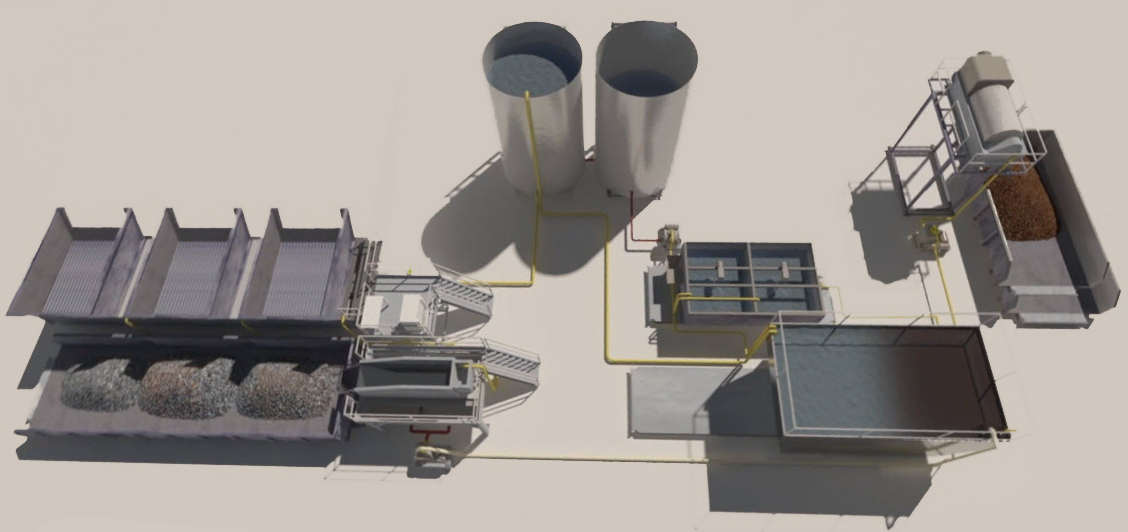The Secret To Highly Effective and Profitable Hydrovac Slurry Processing Lies in Spectur’s Multi-Disciplinary Approach To Soil Dewatering Applications

With over 120 years of combined solids control and dewatering expertise to draw from within its manufacturing group, Spectur possesses the unique ability to design and build customized mechanical soil dewatering systems for the construction industry.
And regardless of the dewatering application, Spectur’s approach is always the same ….
Determine Objective. Evaluate Variables. Develop Solution
Spectur’s approach starts with defining the specific objective for processing Hydrovac Slurry, evaluating all the related variables involved, and then developing a customized solution that meets the stated objective … round peg into a round hole. This approach is in direct contrast with developing a processing system out of off the shelf equipment that can potentially only achieve the stated objective most of the time … round peg into a square hole.
The difference between a customized versus re-purposed approach is based on what you want. If close enough is good enough, if getting the desired result 50% to 60% of the time does the job, then lining up good off the shelf separation equipment may suffice for your processing requirements.
But if you consistently want to have minimal down time, clean enough water, and dry enough solids, you have to work with a processing application that’s designed to specifically meet your requirements.
In Dewatering 101, the objective for Hydro Vac Slurry Processing was defined as follows…
Hydrovac Slurry needs to be disposed of at a processing facility that has the ability to dewater the slurry so that processed water can be cleaned to the regulatory requirement and processed solids can be sufficiently dried for either re-use or disposal ...processing to be completed in real time.
To meet this objective, there are numerous operational variables to address both individually and collectively (See Dewatering 101). Several disciplines are also necessary to effectively evaluate and then properly manage each variable within a dynamic real time processing system. These disciplines include…
- Process Automation
- Material Handling
- Fluid Dynamics
- Soil Science
- Solids Control Principals
- Basic Polymer Chemistry
- Mechanical, Electrical, and Structural Engineering.
Because it takes a great deal of related experience and expertise to apply all of these properly to a soil dewatering scenario, it’s not uncommon for re-purposed equipment systems to be attempted when there is an absence of a robust multi-disciplinary approach.
In very general terms, this is one of the key ingredients of the secret sauce that separates Spectur processing systems from everyone else.
And while the process to get to the solution is extremely important, the actual solution trumps all.
Key Operating Ingredients
In Dewatering 101, the 5 basic processing steps for a mechanical hydro vac slurry processing system were outlined along with some of the related challenges and recommendations for each step.
In order to successfully complete each of the 5 steps, Spectur systems deploy numerous features that work seamlessly together. Each feature functions within a sub system that is designed to complete one of the processing steps. The orchestration of all features and sub systems is elegantly designed into a semi-automated master control center that is extremely easy to understand and operate.
Operationally, what really sets Spectur’s slurry processing systems apart, and makes them work so well, are what we will describe as the three key operating ingredients from which all features and subsystems are designed around …
- Balanced System Dynamics
- Optimal Utilization of Clarification Technology
- Dual Polishing Approach
Balanced System Dynamics allows for optimal utilization of Clarification Technology which in turn makes dual polishing not only possible but highly effective.
Let’s explore each of these individually …
Balanced System Dynamics
One of the biggest challenges with Hydrovac Slurry Processing is receiving highly variable material composition from load to load (inconsistent input) and making it into a more consistent or homogeneous feed for the processing system in order to generate consistent output (clean enough water and dry enough solids).
Spectur solves this issue by managing the water content in the slurry. As mentioned in Dewatering 101, water is the critical component to be managed in the entire process. Slurry material cannot be properly transported, conditioned, and processed without dynamic water content management.
This is achieved by creating a continuously flowing water circuit that is connected into each of the 5 processing steps. At each step, water levels are managed to add or remove water into the circuit as required.
Making the inconsistent slurry homogenous for processing cannot be achieved without Balanced System Dynamics.
Optimal Utilization of Clarification Technology
First, let’s start with a general definition for Water Clarification …
Water clarification helps remove suspended solids and particulate matter – usually with the help of flocculants and coagulants, which improve settling.
www.veoliawatertechnologies.co.uk
Clarification has more than one application in water treatment. It’s usual purpose in a conventional treatment process is to reduce the solids load after coagulation and flocculation.
http://www.bqua.com
Clarification technology has been used for millennia to remove solids from water in numerous industries including but not limited to Sewage Treatment, Pharmaceutical, Construction, Food Processing, Rendering, Pulp & Paper, Oil & Gas, and Mining.
So from a developed technology perspective, the Clarification Concepts being referred to are nothing new. What is always new and ever changing is the way Clarification gets applied to different applications. Hydro Vac Slurry Processing is no different in this regard.
It’s also unlikely that you’ll come across a mechanical dewatering system that doesn’t use Clarification Technology somewhere within its overall system design. The key to optimal utilization of the technology is the where, how, and why it’s being used inside any given system.
From Dewatering 101, Here Are The Basic Mechanical Dewatering System Process Steps ...
Receiving
Screening
Incorporating Chemistry
Agglomeration & Separation (primary processing)
Polishing (secondary processing)
To boil it down even further, for Hydrovac Slurry Processing within a mechanical soil dewatering system, Clarification can be used for primary processing (Step #4), secondary processing (Step #5), or both. Optimal Utilization of the technology allows the overall system to be designed to produce cleaned water and dried solids that consistently meet or exceed the regulatory and commercial requirements for both.
This can only be achieved using Water Clarification as the “Primary Processing Step”.
So even though our original definition for dewatering was “removing water from soil”, we’re now going to expand it to read “removing water from soil and removing soil from water”. Clarification removes soil or solids from water. As the primary processing step, this needs to happen before the removal of water from soil.
Why?
There are several reasons.
First, if you refer back to the 5 Steps of a basic Mechanical Soil Dewatering process, Step #4 - Agglomeration and Separation is the primary and most difficult processing step.
This is where over 99% the suspended solids need to be removed from the slurry or you’ll never get the water clean enough for re-use or low cost disposal.
To consistently achieve that level of suspended solids removal, Agglomeration and Separation must have the necessary flow rate, rise distance, rise frequency, and retention time. This can only be accomplished using Clarification Technology.
Second, use of Clarification in Step #4 will require the least amount of chemistry to complete Agglomeration and Separation, minimizing your total chemistry cost and eliminating the risk of over polymerization which will impact the cleaned water quality and potentially “blind” screens if cleaned water is re-used in the processing system.
Third, while turbulent flow is used to condition and move the slurry material through the process, it also continuously breaks down the remaining solids into smaller and smaller particles, making them more difficult to remove from the slurry. Therefore, it’s important to reduce or eliminate turbulent flow as soon as possible. The earliest that the slurry flow can be changed from turbulent to laminar is at the start of Step 4, provided Clarification Technology is being utilized at that point.
Fourth, utilization of Clarification Technology in Step #4 creates the ability for the system to be designed to perform dual polishing in Step #5 (removal of additional suspended solids that remain in the water and removal of additional water from the separated solids).
Done properly, the sudden radical separation of the hard to remove colloidal solids from the slurry through properly applied clarification technology can seem like a magic trick, especially when so many systems struggle with effective suspended solids removal.
It’s not magic.
Its applied science … that Spectur’s manufacturing group has designed and installed into hundreds of pieces of soil dewatering equipment over the last 30 years. Development and refinement of dewatering systems by the group is continuous with each application requiring its own unique customizations.
Dual Polishing Approach
Spectur’s dual polishing approach is another key ingredient to the operational success of the overall system and is made possible by Balanced System Dynamics and Clarification.
The first stage in Step #5 - Polishing, is the removal of water from solids.
In Step #4, Clarification allows solids to rapidly settle out of water. Through the force of gravity, solids fall out of solution and are allowed to accumulate at the bottom of a settling tank. The weight of the column of water directly above the solids combined with a continuous buildup of solid material provides the pressure necessary to condition the separated solids into a dense sludge.
Increasing the density of the sludge is a dewatering step in itself. Once sufficiently accumulated, the sludge material is pumped over to a second piece of soil dewatering equipment (secondary processing).
In the Spectur Hydrovac Slurry Processing System, soil polishing is accomplished with a Centrifuge which can be calibrated for how dry you want the processed solids.
A Centrifuge is an ideal solids polisher if it can be fed a consistent slurry mixture that is at or near 20% solids content.
The water removed during soil polishing is returned to the Clarification Unit for further water polishing (secondary processing)
The Centrifuge design utilized by Spectur has a custom feed chamber that increases its polishing efficiency.
In most commercial and industrial processing applications where a Centrifuge is utilized, the centrifuge is a polisher at the end of the processing system since it doesn’t work very well with an inconsistent level of solids in the material feed. High volume, real time processing of solids with a centrifuge is not possible without a consistent material feed that’s at or close to 20% solids content.
Hydrovac Slurry Processing Systems that utilize a Centrifuge for primary processing in Step 4 will struggle to get clean enough water and dry enough solids for this very reason.
Cleaned water from the Clarification unit is either re-used by the system, or sent to vertical water barrels that provide added retention for further polishing (secondary processing) of any remaining suspended solids.
Orchestration and Harmonization
The overall effectiveness of the Spectur Hydrovac Slurry Processing Systems can be contributed to both Orchestration and Harmonization.
Orchestration is not limited to the physical operation of the equipment. It also needs to include all functional elements and disciplines discussed, which are required to process Hydrovac Slurry.
Spectur’s system is designed to run all day long in a ready state of operation so that regardless of the slurry mixtures being received, or the time gap from one receiving load to the next, all elements, disciplines, and equipment are working harmoniously.
The effectiveness of any slurry processing plant will be based on how well everything in the processing system works together on a continuous basis.
Without question, this is the single biggest key to operational success.
